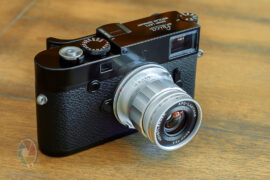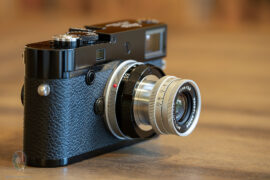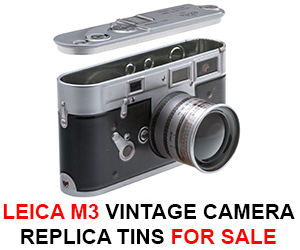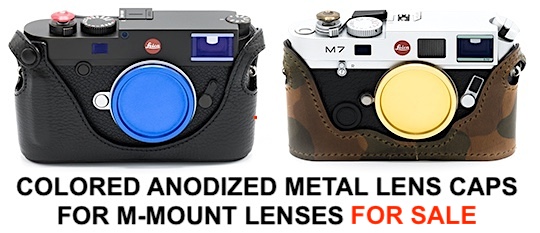Fred Miranda published a review of the new Voigtlander APO-LANTHAR 50mm f/3.5 Type I / II VM lens for Leica M-mount (orders now open at B&H | Koch | Calumet | PopFlash Jo Geier). Here is the final conclusion:
After over three weeks of hands-on experience with the Voigtlander 50mm f/3.5 APO-Lanthar, including some rigorous testing, I was genuinely surprised by how hard it was to find any optical flaws. In fact, it’s one of the rare occasions where I couldn’t pinpoint a single issue with its optical performance. The only critiques I have are more about its aesthetics and functionality.
Many of us were initially excited about the Type I version of this lens, especially the idea of a modern APO ‘collapsible’ lens with a design reminiscent of the 1950s. However, it soon became clear that this lens doesn’t actually collapse. Cosina justified this design choice by citing concerns about airflow introducing dust onto digital sensors and the need to minimize vibration by maintaining a rigid structure. Given the high precision required to achieve the lens’s performance, it’s understandable that a collapsible design could compromise those tight tolerances. So, while the vintage-inspired look is appealing, the lack of true collapsibility might not be a dealbreaker, depending on your priorities.
As for the Type II version, its main drawback is that the aperture and focus ring are linked, making it challenging to change the aperture settings after focusing. This demands a bit more discipline, requiring shooters to set the aperture first before focusing. However, for those already familiar with lenses like the Voigtlander 50mm f/3.5 Heliar or the Voigtlander 28mm f/2.8 and 40/2.8 Color-Skopar lenses, this won’t be a significant issue.
Beyond these minor concerns, the Voigtlander 50mm f/3.5 APO-Lanthar, much like the 50mm f/2 APO-Lanthar, comes close to optical perfection. It even surpasses expectations by delivering distortion-free images, thanks to its inspired Planar optical design and slightly less optical vignetting, which results in less cat’s-eye-shaped bokeh in the corners compared to the Voigtlander 50mm f/2 APO-Lanthar.
In terms of resolution and contrast, I anticipated high performance based on the released MTF graph but was pleasantly surprised to find it exceeding even those predictions. When the Voigtlander 50mm f/2 APO-Lanthar is stopped down to f/3.5, the Voigtlander 50mm f/3.5 APO-Lanthar’s wide-open performance at f/3.5 matches it, with the only noticeable difference being less vignetting on the f/2 APO-Lanthar due to being stopped down. Because of this, despite its compact size, the Voigtlander 50mm f/3.5 APO-Lanthar is a lens I wouldn’t hesitate to shoot wide open for optimal results, only stopping down for a broader depth of field rather than to correct aberrations.
Although it lacks a floating element, this doesn’t detract from its remarkable performance at close focus distances, even wide open. In the Type II version, the magnification approaches macro levels, adding to the lens’s versatility.
Speaking of close focus, with more photographers using Live View or adapting Leica M lenses to mirrorless cameras, the ability to focus down to 0.35m in Type II and 0.45m in Type I is a valuable feature for close-ups. Cosina thoughtfully designed a tactile mechanism to indicate when rangefinder focusing is no longer possible below 0.7m, signaling that Live View should be used for closer focusing.
This lens shows a flat-field curvature shape from close to infinity, ensuring the focus plane remains parallel to the subject. This makes it ideal for applications like landscape, street, and architectural photography. Its complete lack of chromatic aberration rivals that of much larger and more expensive lenses, offering outstanding image quality without the hefty price tag.
The lens also produces well-defined 10-pointed sunstars from f/4 to f/16, thanks to its 10 straight aperture blades — a characteristic found in most Cosina lenses.
Its simple design and small front element make the lens highly resistant to flare, on par with the best Cosina lenses.
Compared to the now-discontinued Voigtlander 50mm f/3.5 Heliar, a lens renowned for its high resolution and contrast, the Voigtlander 50mm f/3.5 APO-Lanthar not only enhances these qualities but also preserves a similar rendering. This makes it a compelling upgrade for Heliar users, especially considering the Heliar’s minimum focus distance of only 0.7m.
Rendering is where this lens truly excels. It delivers smooth transitions while retaining some character, a quality I personally find more appealing than the faster Voigtlander 50mm f/2 APO. Although the f/2 can create more blur, its more modern and predictable rendering is often preferred by many.
For those who already own the Voigtlander 50mm f/2 APO-Lanthar, the most compelling reasons to upgrade or add the Voigtlander 50mm f/3.5 APO-Lanthar to your gear are its smaller size, lighter weight, and much closer minimum focus distance. Also, as shown in the resolution and contrast test on the stock Sony A7CR, the CV 50/3.5 APO outperforms the f/2 APO version when adapted. If you plan to use the lens on a mirrorless body instead of a Leica M, I recommend the f/3.5 version, as it performs nearly as well on Sony, although the Leica M will always be the optimal choice. Although not tested, it will likely offer the same outstanding performance when adapted to Nikon and Canon bodies as well.
Many of us already have too many 50mm lenses because they are versatile for many applications, so only something truly special could entice us to add another one. If you prioritize image quality, color aberration control and appreciate shooting with a truly compact lens that won’t block your Leica M framelines, it might just make sense to make some space for another nifty fifty!
Pros:
- The lens delivers outstanding resolution and contrast, even when wide open, from minimal focus distance to infinity.
- Performs nearly as well when adapted to mirrorless bodies other than Leica.
- There is no noticeable distortion.
- The rendering is pleasant and has a distinctive character.
- The lens exhibits flat-field curvature.
- It features a compact design that doesn’t obstruct the 50mm framelines.
- Sunstars are well-defined, starting from f/4 and continuing through f/16.
- The lens offers strong flare resistance.
- Lateral chromatic aberration is negligible.
- Purple fringing and Axial chromatic aberration is undetectable.
- Extended minimal focus distance for LiveView shooting, with 0.45m for Type I and 0.35m for Type II.
Cons:
- The f/3.5 aperture may be too slow for low light shooting conditions.
- The Type I model is not collapsible, despite what the design might suggest.
- The Type II model combines aperture and focus control on the same ring, which some users may find inconvenient.
Previous Fred Miranda reviews can be found here.
Additional information on the Voigtlander APO-LANTHAR 50mm f/3.5 Type I / II VM lens can be found here:
The new Voigtlander APO-LANTHAR 50mm f/3.5 Type I / II VM lenses are now available for pre-order
New Voigtlander APO-LANTHAR 50mm f/3.5 Type I / II VM lenses for Leica M-mount announced






















